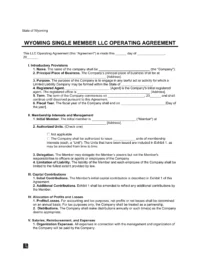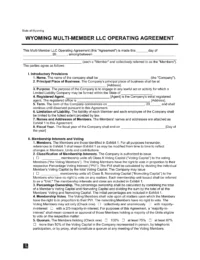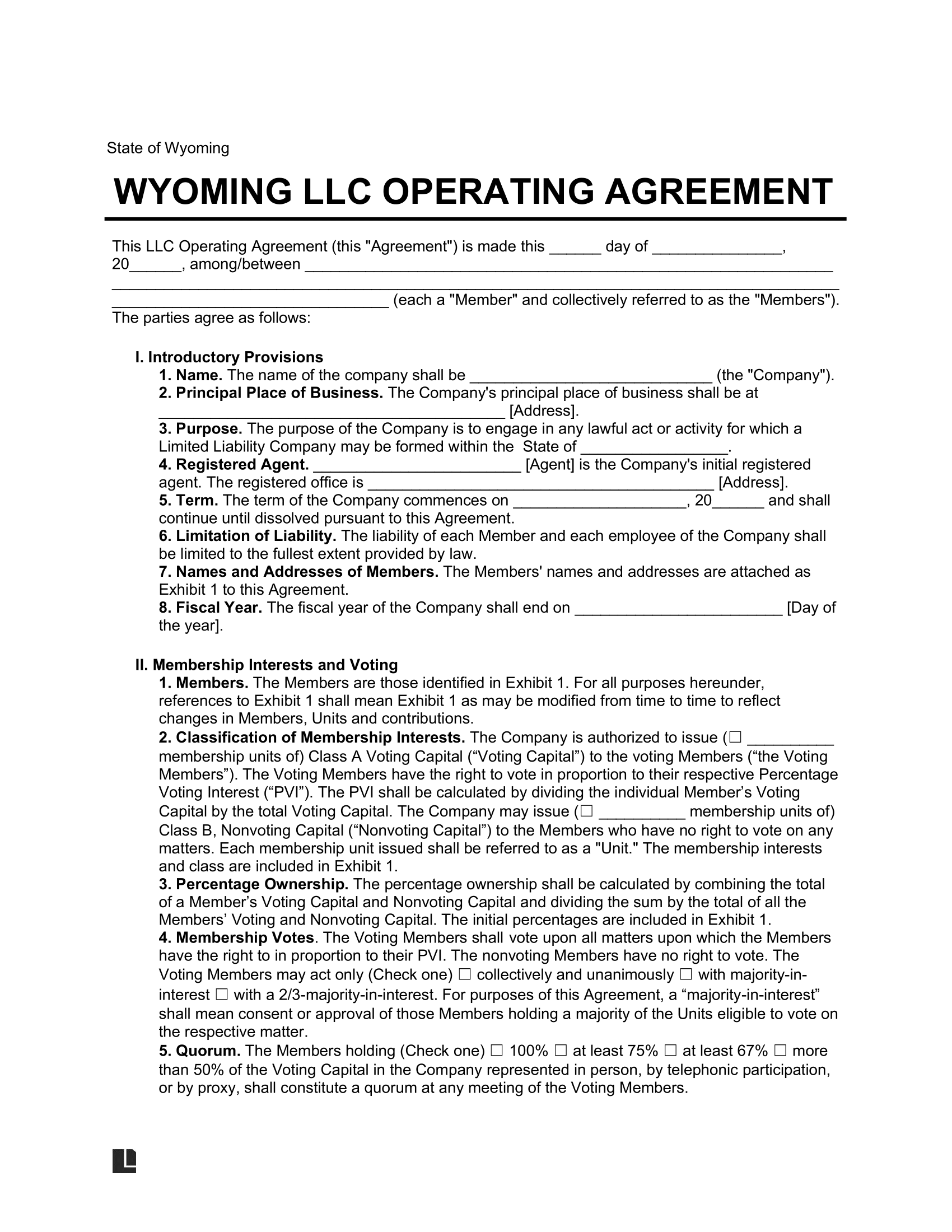A Wyoming LLC operating agreement is a document that conveys an LLC’s operational procedures and the duties and rights of each member. It’s a go-to resource for promoting efficiency and solving any issues that may arise within the company.
An LLC’s members can come together to decide on the details of an operating agreement. Once everyone signs the document in agreement with one another, each member can keep a copy for themselves.
Is an LLC Operating Agreement Required in Wyoming?
No, you don’t need an operating agreement to conduct business as an LLC in Wyoming.
By Type
Single-Member LLC Operating Agreement
Allows a sole business owner to define aspects of their LLC, including recordkeeping and profit distribution.
Multi-Member LLC Operating Agreement
Records how a business will conduct itself and includes elements like its management structure and financial procedures.
Laws
The Wyoming Limited Liability Company Act (Title 17, Chapter 29) includes guidance on how LLCs conduct themselves.
If you want to create your own operating agreement to have more control over your business’s daily activities, you can review the specific guidance on operating agreements:
- § 17-29-110 (Operating agreement; scope, function, and limitations)
- § 17-29-111 (Operating agreement; effect on limited liability company and persons becoming members; preformation agreement)
- § 17-29-112 (Operating agreement; effect on third parties and relationship to records effective on behalf of limited liability company)
Costs and Fees
Here are some of the costs and fees that come with owning and maintaining an LLC in Wyoming:
- Domestic and foreign filing fee: $100 ($102 if you file online)
- Name reservation fee: $60
- Annual report license tax fee: $60 or two-tenths of one mill on the dollar, whichever is greater based on the LLC’s assets
How to Form an LLC in Wyoming
The process of applying for an LLC in Wyoming isn’t difficult once you have the pieces in place. When figuring out how to create an LLC in Wyoming, following these steps will point you in the right direction on how to get an LLC in Wyoming:
Step 1 – Name the LLC
Think of a name for your LLC that accurately reflects your scope of business. Search the Secretary of State’s business name database to determine if another Wyoming business already uses your desired name.
For whatever name you pick, include “Limited Liability Company” or an abbreviation like “LLC” after it to identify your business entity properly.
If you want to reserve your business name, you can do so for up to 120 days through the Secretary of State.
Step 2 – Appoint a Registered Agent
As an LLC owner, you must have an appointed registered agent. This person or business will receive any important legal documents served to your LLC. In Wyoming, the registered agent must have a physical address in Wyoming. This address cannot be a mail forwarding service or P.O. box.
You can elect someone within your company to be the registered agent. If you need to find a registered agent, there’s a roster of Wyoming Commercial Registered Agents on the Secretary of State’s website.
Step 3 – File the Articles of Organization
File your LLC’s articles of organization to officially register the business. Include the following information within your articles of organization:
- The organizer’s name and signature
- The consent to appointment by the registered agent
- The registered agent’s name and address
- The LLC’s name and mailing address
- The effective date of the LLC
Step 4 – Pay the Filing Fee
Once the paperwork is filed, you will pay the filing fee. If done online, you will be able to pay it immediately with one of the options listed. If filing manually, you will print the paperwork and send it with a check to the Wyoming Secretary of State. Your LLC won’t be registered if you do not pay this fee. Filing online may expedite the process.
Step 5 – Create your Operating Agreement
Again, while operating agreements are not required in Wyoming, it is a good idea to have one and keep it with your organization’s records. This document can dictate certain aspects of your company, including:
- Losses and profit distribution
- Buy-sell and buyout rules
- Meeting procedures
- Dissolution procedures
- Members’/managers’ level of authority
- Members’/managers’ responsibilities
Step 6 – Obtain an EIN
An Employer Identification Number (EIN) is necessary for opening a bank account and hiring employees. You can obtain one by mail or fax, but the easiest method is to apply online.
Step 7 – File Your Annual Reports
File your annual reports on the first day of your company’s anniversary. Completing this task ensures your business stays in good standing with the state. You can also amend an annual report online if any changes arise.
Sample



